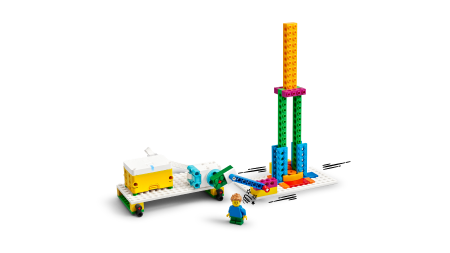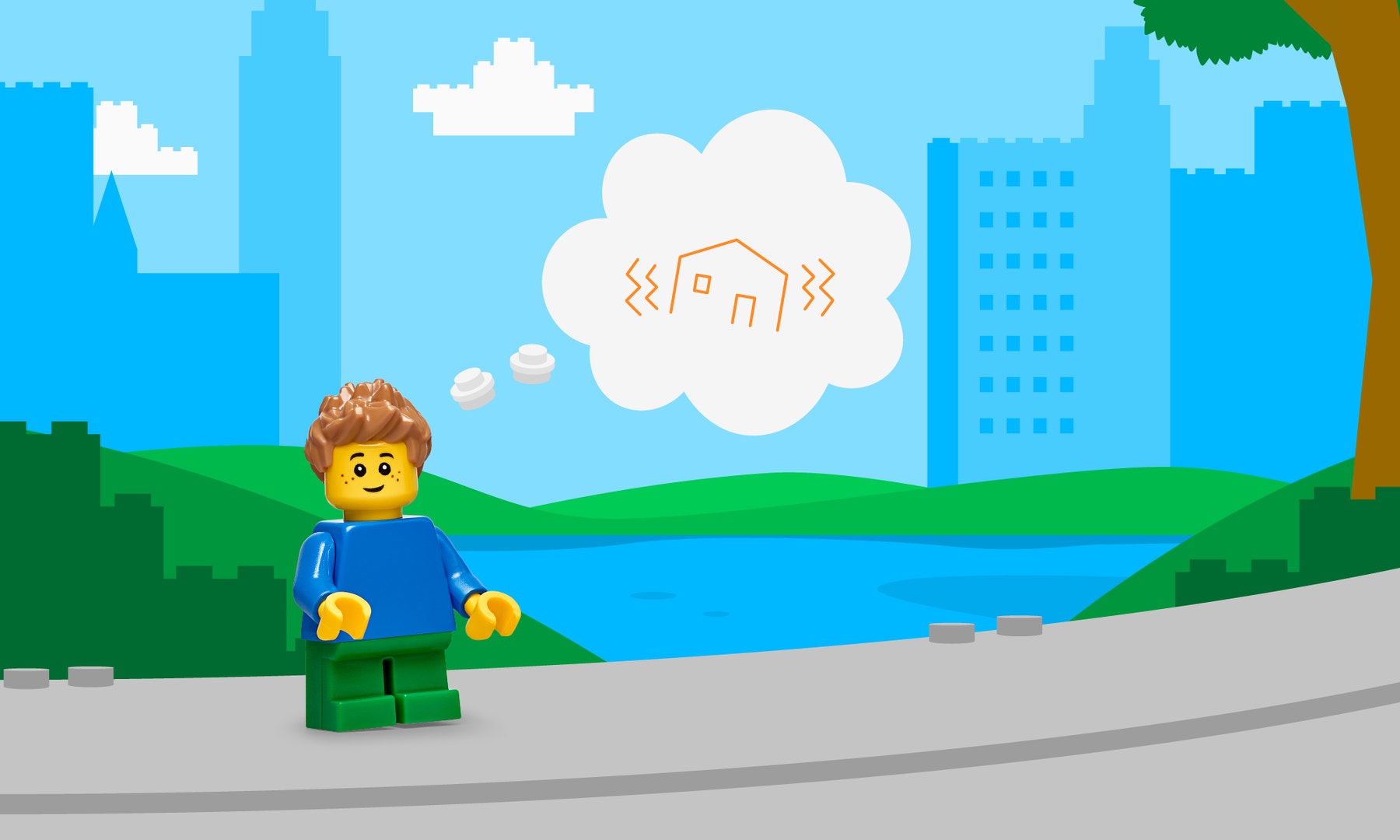Prepare for Natural Hazards
Leo knows some places have earthquakes. To keep people safe, help him design buildings that won’t be destroyed by earthquakes.

Prepare
(NOTE: This lesson contains a Part A and a Part B. Both are important to access the full learning of the standard. If time is limited, review both parts to choose elements that meet your students’ needs.)
In this lesson, the learning occurs through comparing multiple ways to reduce the impacts of earthquakes on buildings and the people who use them. The class must therefore build multiple different solutions to support comparison. The example model/program shows some possible building designs, along with a machine for testing. Guide students to use the examples for inspiration and then to design and build their own idea for an earthquake-resistant structure.
Note that each student group creates one building design. Groups then compare designs and results. Help students create comparison criteria.
Science Background - Earthquakes: Natural Earth processes, such as a sudden slip of the Earth’s crust or volcanic activity, can cause earthquakes.
Build Prior Knowledge - Preparing for Earthquakes: Using your core science materials (and videos if located - see Materials), share information, images, and definitions.
- Earthquakes are one hazard resulting from a natural process on Earth (others include floods, tsunamis, and volcanic eruptions). During an earthquake, the ground can shake violently, which can damage or destroy buildings and threaten people’s safety.
- People can reduce the impacts (effects) of earthquakes in many ways, such as designing earthquake-resistant buildings. These buildings use both shapes and materials to reduce danger. They also have parts that are meant to be damaged to keep the whole building from failing, similar to how fenders in a car can crumple to protect the people inside by absorbing the energy from an accident.
- Preparedness, such as with hazard emergency alarm systems, also alerts people to get to safety quickly.
- Key vocabulary: Earth processes, natural hazard, earthquake
Building and Programming Experience: Review the suggestions in the Unit Plan. For this lesson, you may also want to
- Reinforce with the Motor tutorial in the SPIKE App Start menu.
- Use the Event and Motor Blocks sections of the Help>Word Blocks menu in the SPIKE app to provide more support.
Materials: Locate videos of earthquake shake tests (search: earthquake-resistant structures). If you wish, share these when building background.
PART A (45 minutes)
Engage
(Whole Class, 10 minutes)

Introduce the story’s main character(s) and the first challenge: Leo knows some places have earthquakes. To keep people safe, help him design buildings that won't be destroyed by earthquakes.
THINK—Facilitate a brief discussion about the lesson topic(s), using the story picture if you wish.
- What shapes of buildings are least likely to be damaged by earthquakes? Why? (triangular and pyramid shapes; they are stable and sway the least.)
- What building materials hold up well to an earthquake’s shaking force? Why? (steel; It’s strong but still bends rather than breaks.)
- How can people design buildings to reduce the effects of earthquakes? (Use appropriate materials/shape, like steel + a triangular shape; test and improve designs to find the best solution.)
Distribute a SPIKE™ Essential Set and a device to each group.
Explore
(Small Groups, 25 minutes)
As students work, consider sharing the examples below as support for building or programming. Clarify that they show suggestions for earthquake-resistant structures. Student groups should design and build their own idea for such a structure.
Have students:
- Use the base model to BUILD a building and a shaking machine that simulates an earthquake. Use the machine to test the building design to see if it will be destroyed by earthquakes.
- PROGRAM their model to shake the building at different motor speeds. Test and record how long it stands at different speeds (shaking force). Remember to start the testing from a low speed and then increase (25%, 50%, 75% and 100%). Identify building designs that fall right away. Why?
Facilitate brainstorming about ways to use LEGO® elements to create building models that will behave differently during testing (e.g., because they’re different sizes or shapes—tall and narrow or top-heavy with a wide base—or use flexible pieces that bend but don’t break. Explore ways to use the motor speed to represent increasing force on the building.
Halfway through work time, have students exchange ideas using a familiar classroom routine and then update their models with inspiration from sharing.
Example Ideas
.png?locale=en-us&auto=webp&format=jpeg&width=216&height=124&quality=90&fit=bounds)
.png?locale=en-us&auto=webp&format=jpeg&width=216&height=124&quality=90&fit=bounds)
.png?locale=en-us&auto=webp&format=jpeg&width=216&height=124&quality=90&fit=bounds)
.png?locale=en-us&auto=webp&format=jpeg&width=216&height=124&quality=90&fit=bounds)
.png?locale=en-us&auto=webp&format=jpeg&width=216&height=124&quality=90&fit=bounds)

Explain
(Whole Class, 10 minutes)
Gather students for sharing.
Have each group use their model and sketches to demonstrate and explain:
- Their building design. (Prompt them to describe size, base shape, structure, or flexibility of materials.)
- Their testing results.
- Why the building design solution worked or failed.
Have students individually use the presented explanations and testing results to decide which design solution will best reduce the effects of earthquakes on people. They should compare at least two designs to explain their choice.
Invite students to share how they changed their model to improve its performance.
If you wish to continue to Part B—Explain, have students keep their models intact or allow time for rebuilding.
PART B (45 minutes)
Explain
(Whole Class, 10 minutes)
- Repeat the steps from Part A—Explain to have additional groups demonstrate and explain their learning.
Elaborate
(Whole Class, 30 minutes)
(5 min) Share background to help students Elaborate: In some parts of the United States, the ShakeAlert® system (an earthquake early warning system) sounds a siren to tell people that an earthquake has begun and shaking will soon take place.
(15 min) Have your students iterate and test their models to complete the next challenge in the app:
- Improve and program their building model so that an alarm warns people that an earthquake is coming.
(10 min) Invite students to share knowledge, ideas, or skills that
- Helped them complete the challenge.
- They learned while building.
Have students clean up the sets and work areas.

Evaluate
(Whole Class, 5 minutes)
- Ask guiding questions to elicit students’ thinking and their decisions while ideating, building, and programming.
Observation Checklist
Review the learning objectives (Teacher Support box).
Share specific student responses and behaviors at different levels of mastery.
Use the checklist to observe students’ progress:
- Their model and program include a building and an earthquake simulator that work together to test the building’s shake resistance.
- They use criteria to evaluate how well their solution works to reduce the impacts of an earthquake on humans.
- Their explanation compares at least two building models to decide which works best.
Self-Assessment
Have each student choose the brick that they feel best represents their performance。
- Blue brick: I think I can follow instructions to create a program.
- Yellow brick: I can follow instructions to create a program.
- Green brick: I can follow instructions to create a program, and I can help a friend do it too.
Peer-Feedback
In their small groups, have your students discuss their experiences working together.
Encourage them to use statements like these:
- I liked it when you…
- I’d like to hear more about how you…
Differentiation
Simplify this lesson by:
- Adjusting the first challenge: Have students test their building at one shaking speed only. Provide a time limit for deciding if the building falls “immediately,” such as 5 or 10 seconds.
Increase the difficulty by:
- Extending the Elaborate challenge: Have students change their Elaborate models to show additional ways to alert people about the danger of a natural hazard.
Extension
- Provide learning materials about materials used by ancient Japanese, Chinese, or Roman builders to resist earthquake damage. (Search ancient Chinese/Japanese/Roman earthquake proof buildings) Have students examine one example and share the key concepts and details from their learning.
If facilitated, this will extend beyond the 45-minute lesson.
Language Arts: CCSS.ELA-LITERACY.RI.4.3
Teacher Support
Students will:
- Design a model for buildings that will reduce the impacts of earthquakes on humans.
- Use their model to evaluate the effectiveness of their design solution.
- Use several models to compare the effectiveness of two or more design solutions.
(one for every two students)
- LEGO® Education SPIKE™ Essential Set
- Device with the LEGO Education SPIKE App installed
- See Prepare - Materials
Meet the team: Minifigure Bios
- NGSS 4-ESS3-2: Generate and compare multiple solutions to reduce the impacts of natural Earth processes on humans.
- NGSS 3-5-ETSI-1
- CSTA 1B-AP-15
- ISTE 1.4.c
- CCSS.ELA. LITERACY.SL.4.1
Language Arts Extension
- CCSS. ELA-LITERACY.RI.4.3




